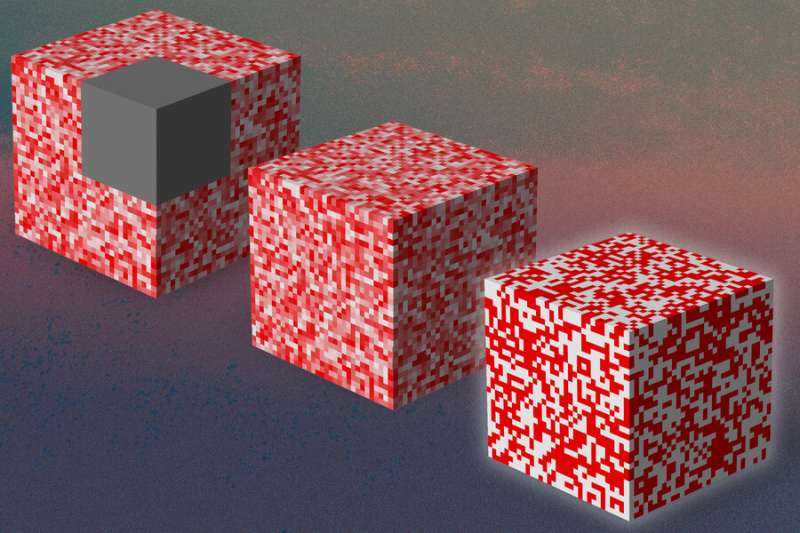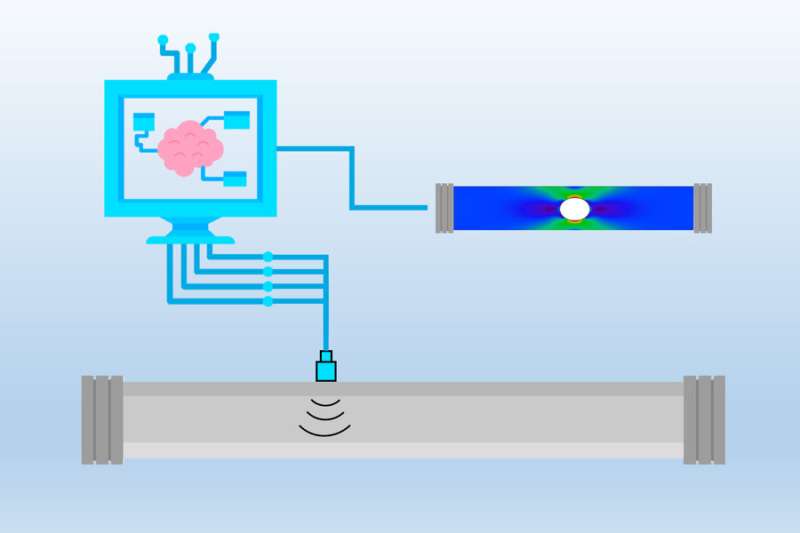Deep-learning system explores materials’ interiors from the outside

Maybe you can’t tell a book from its cover, but according to researchers at MIT you may now be able to do the equivalent for materials of all sorts, from an airplane part to a medical implant. Their new approach allows engineers to figure out what’s going on inside simply by observing properties of the material’s surface.
The team used a type of machine learning known as deep learning to compare a large set of simulated data about materials’ external force fields and the corresponding internal structure, and used that to generate a system that could make reliable predictions of the interior from the surface data.
The results have been published in the journal Advanced Materials, in a paper by doctoral student Zhenze Yang and professor of civil and environmental engineering Markus Buehler.
“It’s a very common problem in engineering,” Buehler explains. “If you have a piece of material—maybe it’s a door on a car or a piece of an airplane—and you want to know what’s inside that material, you might measure the strains on the surface by taking images and computing how much deformation you have. But you can’t really look inside the material. The only way you can do that is by cutting it and then looking inside and seeing if there’s any kind of damage in there.”
It’s also possible to use X-rays and other techniques, but these tend to be expensive and require bulky equipment, he says. “So, what we have done is basically ask the question: Can we develop an AI algorithm that could look at what’s going on at the surface, which we can easily see either using a microscope or taking a photo, or maybe just measuring things on the surface of the material, and then trying to figure out what’s actually going on inside?” That inside information might include any damages, cracks, or stresses in the material, or details of its internal microstructure.
The same kind of questions can apply to biological tissues as well, he adds. “Is there disease in there, or some kind of growth or changes in the tissue?” The aim was to develop a system that could answer these kinds of questions in a completely noninvasive way.
Achieving that goal involved addressing complexities including the fact that “many such problems have multiple solutions,” Buehler says. For example, many different internal configurations might exhibit the same surface properties. To deal with that ambiguity, “we have created methods that can give us all the possibilities, all the options, basically, that might result in this particular [surface] scenario.”
The technique they developed involved training an AI model using vast amounts of data about surface measurements and the interior properties associated with them. This included not only uniform materials but also ones with different materials in combination. “Some new airplanes are made out of composites, so they have deliberate designs of having different phases,” Buehler says. “And of course, in biology as well, any kind of biological material will be made out of multiple components and they have very different properties, like in bone, where you have very soft protein, and then you have very rigid mineral substances.”

The technique works even for materials whose complexity is not fully understood, he says. “With complex biological tissue, we don’t understand exactly how it behaves, but we can measure the behavior. We don’t have a theory for it, but if we have enough data collected, we can train the model.”
Yang says that the method they developed is broadly applicable. “It is not just limited to solid mechanics problems, but it can also be applied to different engineering disciplines, like fluid dynamics and other types.” Buehler adds that it can be applied to determining a variety of properties, not just stress and strain, but fluid fields or magnetic fields, for example the magnetic fields inside a fusion reactor. It is “very universal, not just for different materials, but also for different disciplines.”
Yang says that he initially started thinking about this approach when he was studying data on a material where part of the imagery he was using was blurred, and he wondered how it might be possible to “fill in the blank” of the missing data in the blurred area. “How can we recover this missing information?” he wondered. Reading further, he found that this was an example of a widespread issue, known as the inverse problem, of trying to recover missing information.
Developing the method involved an iterative process, having the model make preliminary predictions, comparing that with actual data on the material in question, then fine-tuning the model further to match that information. The resulting model was tested against cases where materials are well enough understood to be able to calculate the true internal properties, and the new method’s predictions matched up well against those calculated properties.
The training data included imagery of the surfaces, but also various other kinds of measurements of surface properties, including stresses, and electric and magnetic fields. In many cases the researchers used simulated data based on an understanding of the underlying structure of a given material. And even when a new material has many unknown characteristics, the method can still generate an approximation that’s good enough to provide guidance to engineers with a general direction as to how to pursue further measurements.
As an example of how this methodology could be applied, Buehler points out that today, airplanes are often inspected by testing a few representative areas with expensive methods such as X-rays because it would be impractical to test the entire plane. “This is a different approach, where you have a much less expensive way of collecting data and making predictions,” Buehler says. “From that you can then make decisions about where do you want to look, and maybe use more expensive equipment to test it.”
To begin with, he expects this method, which is being made freely available for anyone to use through the website GitHub, to be mostly applied in laboratory settings, for example in testing materials used for soft robotics applications.
For such materials, he says, “We can measure things on the surface, but we have no idea what’s going on a lot of times inside the material, because it’s made out of a hydrogel or proteins or biomaterials for actuators, and there’s no theory for that. So, that’s an area where researchers could use our technique to make predictions about what’s going on inside, and perhaps design better grippers or better composites,” he adds.
More information:
Zhenze Yang et al, Fill in the Blank: Transferrable Deep Learning Approaches to Recover Missing Physical Field Information, Advanced Materials (2023). DOI: 10.1002/adma.202301449
This story is republished courtesy of MIT News (web.mit.edu/newsoffice/), a popular site that covers news about MIT research, innovation and teaching.
Citation:
Deep-learning system explores materials’ interiors from the outside (2023, April 28)
retrieved 28 April 2023
from https://techxplore.com/news/2023-04-deep-learning-explores-materials-interiors.html
This document is subject to copyright. Apart from any fair dealing for the purpose of private study or research, no
part may be reproduced without the written permission. The content is provided for information purposes only.
For all the latest Technology News Click Here
For the latest news and updates, follow us on Google News.

